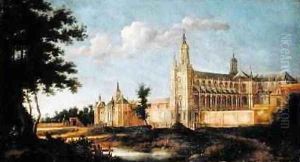Jean Francois Neyts Paintings
Jean Francois Neyts, born in 1639 in Bruges, was a Flemish painter and draughtsman known for his detailed landscapes, architectural scenes, and genre paintings. Neyts was a part of the Flemish school of painting, which was prominent in the Southern Netherlands during the 17th century. His works often reflected the Baroque style, characterized by vivid expression, rich color, and dramatic contrast, which was prevalent in Flemish art of the time.
Neyts received his artistic training in the studio of the Bruges painter Lucas de Meijere, which significantly influenced his early style and choice of subjects. His paintings often depicted the countryside and cities of Flanders with meticulous attention to architectural details, imbuing his scenes with a sense of realism and depth. Neyts’s work was not limited to landscapes; he also produced a number of genre scenes, illustrating everyday life with a keen eye for narrative and detail.
Throughout his career, Jean Francois Neyts developed a distinctive style that set his work apart from his contemporaries. His ability to capture the play of light and shadow, combined with his precise rendering of architectural elements, contributed to a lively and dynamic composition in his paintings. Neyts's landscapes, in particular, are noted for their atmospheric quality and depth, often featuring bustling market scenes or serene rural settings.
Despite his talent, Neyts never achieved the same level of fame as some of his contemporaries like Peter Paul Rubens or Anthony van Dyck. However, his work was appreciated by art collectors and connoisseurs during his lifetime and has gained recognition in recent years for its contribution to the Flemish tradition of painting. Jean Francois Neyts passed away in 1688, leaving behind a body of work that continues to be studied and admired for its craftsmanship and beauty. His paintings are preserved in various museums and collections, serving as a testament to his skill and dedication to the art of painting.
